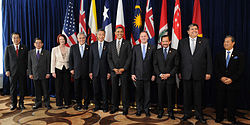Bipartisan Congressional Trade Priorities and Accountability Act of 2015

Leaders of prospective member states at a TPP summit in 2010
|
|
| Type | Trade agreement |
|---|---|
| Drafted | 5 October 2015 |
| Signed | 4 February 2016 |
| Location | Auckland, New Zealand |
| Effective | Not in force |
| Condition | Ratification by all original signatories, or (2 years after signature) ratification by at least 6 states corresponding to 85% of GDP of original signatories |
| Original signatories |
|
| Ratifiers | |
| Depositary | New Zealand |
| Languages | English (prevailing in the case of conflict or divergence), Spanish, and French |
|
|
|
The Trans-Pacific Partnership (TPP), or the Trans Pacific Partnership Agreement (TPPA), is a trade agreement between Australia, Brunei, Canada, Chile, Japan, Malaysia, Mexico, New Zealand, Peru, Singapore, the United States (until 23 January 2017) and Vietnam. A final agreement was drafted on 5 October 2015, made public on 5 November 2015, and signed on 4 February 2016 in Auckland, New Zealand, concluding seven years of negotiations. It is the largest trade agreement in history.
The TPP began as an expansion of the Trans-Pacific Strategic Economic Partnership Agreement (TPSEP or P4) signed by Brunei, Chile, New Zealand, and Singapore in 2005. Beginning in 2008, additional countries joined the discussion for a broader agreement: Australia, Canada, Japan, Malaysia, Mexico, Peru, the United States, and Vietnam, bringing the total number of countries participating in the negotiations to twelve. Current trade agreements between participating countries, such as the North American Free Trade Agreement, will be reduced to those provisions that do not conflict with the TPP or provide greater trade liberalization than the TPP. The Obama administration considered the TPP a companion agreement to the proposed Transatlantic Trade and Investment Partnership (TTIP), a broadly similar agreement between the U.S. and the European Union.
...
Wikipedia
